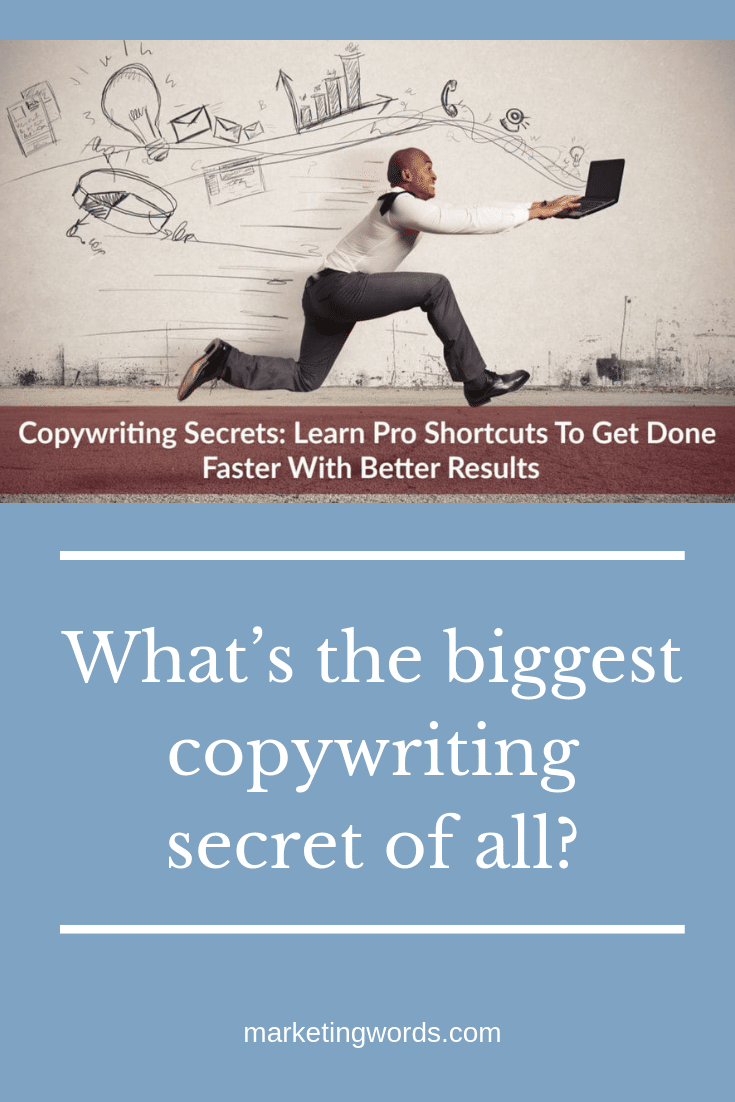
Most people think writing excellent copy is hard to master. And, when you go about it the way that an average person does, it actually is! Professional copywriters, however, have learned a few copywriting secrets over the years about how to cut hours off their writing time while actually getting better results.
What’s the biggest copywriting secret of all … planning. Not what you expected is it?
Let me clarify.
What Does Cooking Have to do with Copywriting?
Do you cook? Or are you familiar with the act of cooking?
Ever hear of the term “mise en place?” It means “everything in its place” or “everything is set up.” Professional chefs live and die by the process of mise en place because it saves them time and prevents their hard work from being ruined.
The idea is to have everything in its place before you start cooking. The meat is on the counter and prepped (fat trimmed, cut into appropriate chunks, if needed). The spices are measured into those cute, tiny bowls. Veggies are sliced and diced and ready to be added. The strainer for the cooked pasta stands ready right beside the sink.
As the cooking process moves along, all the chef has to do is pick up the oregano bowl and empty it into the pot. When the pasta is perfectly al dente, a few steps to the sink is all it takes to strain it.
Can you imagine if a professional chef (or even you or me) tried to prepare an entire meal without planning and prepping first?
Putting the meat into a skillet to brown while you pull all the spices for spaghetti sauce out of the cupboard and grab the measuring spoons could end up in disaster. Your ground beef will quickly turn black and crunchy, while you separate and measure 6 types of seasoning, chop onions, peppers and mushrooms, and add them to the pot.
Getting everything ready to go beforehand saves time and ensures success.
This same process gives primo results when used with copywriting, too.
Focus on Your Focus
Website owners and amateur copywriters typically think about what they want to say instead of what their customers want to hear. They push information out instead of drawing people in to share details. This type of copy is typically centered on what they are trying to get the customer to do instead of what the customer needs/wants.
When you take a little while to do a bit of planning you enter what pros call the “pre-writing stage.” This is equal to an athlete stretching prior to a game, a singer doing vocal exercises before a concert or a doctor reviewing a patient’s file prior to surgery. Essentially, it’s prep time and one of the best-kept copywriting secrets ever.
This magical moment allows you to gather all the information you need into one central place, brainstorm ideas and organize your strategy before committing to a particular direction for the copy.
Describe Your Who
Another copywriting secret is to get to know your audience inside and out. In fact, if you were hiring a copywriter s/he would provide you with an audience profile to complete.
This can seem like a lot of work, and it is, but the great thing about getting to know your readers is that you can use the information again and again. For the next page of copy you write for your site, you won’t need this step, but you may want to review your answers prior to writing.
A Stronger Connection Means More Conversions
With this easy target audience discovery worksheet & video, you’ll have a handy tool that helps all your copy & marketing efforts hit the mark!

I understand that I will also receive weekly articles & videos plus periodic discounts, product notices & more. I can unsubscribe at any time.
Write down detailed information about:
- Target audience’s demographics. (Age, gender, location, etc.)
- Your audience’s primary concern (with regard to the product/service you’re writing about) right now?.
- Why this information should matter to them.
- Your audience’s communication preferences. Do they respond better to long pages or short ones? Video? Audio?
- How do they spend their time?
- Are they likely to be especially distracted as they read?
These are a few basic questions. There are dozens of others. The more detail you collect, the deeper your connection, and the more fruitful the conversation.
If you can’t answer some of these questions, ask. Whether you survey your newsletter readers, ask on social media, or call a few of your best clients and get their perspective, you don’t want to guess or make up the answers.
The information you collect will help shape your copy. For the professional, knowing readers are apt to be distracted means using extra subheads so the preoccupied can easily find their place after an interruption. Being aware of what they’re thinking about lets you “enter the conversation already happening in your reader’s mind” as Dan Kennedy says.
When you know your audience well your writing will connect with them in an entirely different way. They’ll be able to trust you—and thus will follow your recommendations—because you’ve demonstrated that you understand them. In today’s noisy world, it’s easy for people to feel misunderstood and taking the time to get to know your website visitors on an intimate level helps avoid this mistake.
Find Your Why
Every page must have one main goal. That’s not to say you can’t expect your copy to do multiple things. For instance, it’s common to hope the home page will welcome new visitors, encourage subscriptions to your list, and lure people into reading your blog. But professionals know the importance of choosing one primary goal for each page they write.
Choosing a singular focus is yet another copywriting secret. A scattered voice leaves your readers feeling unsure what to do next, while a confident voice directs them from point A to point B elegantly.
Your goal should determine every choice you make about copy. In this way, you can help visitors follow a straightforward path to the action you want them to take.
Organize Your Thoughts
Once you know who your audience is—in great detail—and you know why you’re writing this particular page, you’re almost ready to put pen to paper. But there’s still one more copywriting secret pros know that amateurs skip: forethought.
Think about what you’re going to say, how you’re going to say it, what the overall message will be. Jot some notes, practice a few headlines and opening paragraphs, and give some thought to how you (if you were in your customers’ shoes) would respond to the direction of the copy.
- Does the copy answer the specific needs and/or objections of your audience?
- Does the copy engage the reader or try and force information down their throats?
- Are you writing ABOUT your products/services or are you writing FOR your target customers?
- Have you included keywords for SEO? Which ones, where and why?
“Wait a minute. How does this save me time?” you might be asking. Because, after you get everything organized and laid out, your copy will pretty much write itself. The entire writing process will flow more easily without the typical frustration and back-and-forth confusion that you may have experienced in the past.
And, because you have taken the professional “pre-writing” approach, the copy is also much more likely to get better results than if you simply put fingers to keyboard and began rattling off with no direction.
What many writers don’t realize is that most of the magic of copywriting happens long before the first word is ever written. This is the part of the process that is time consuming. Get everything in order before you begin and you can cut your writing time in half!

Ready to kick up your copywriting skills? Find your copywriting advantage with my Copywriting Advantage: How to Communicate, Convince & Convert copywriting course and save 25% today with code COPYADV.




